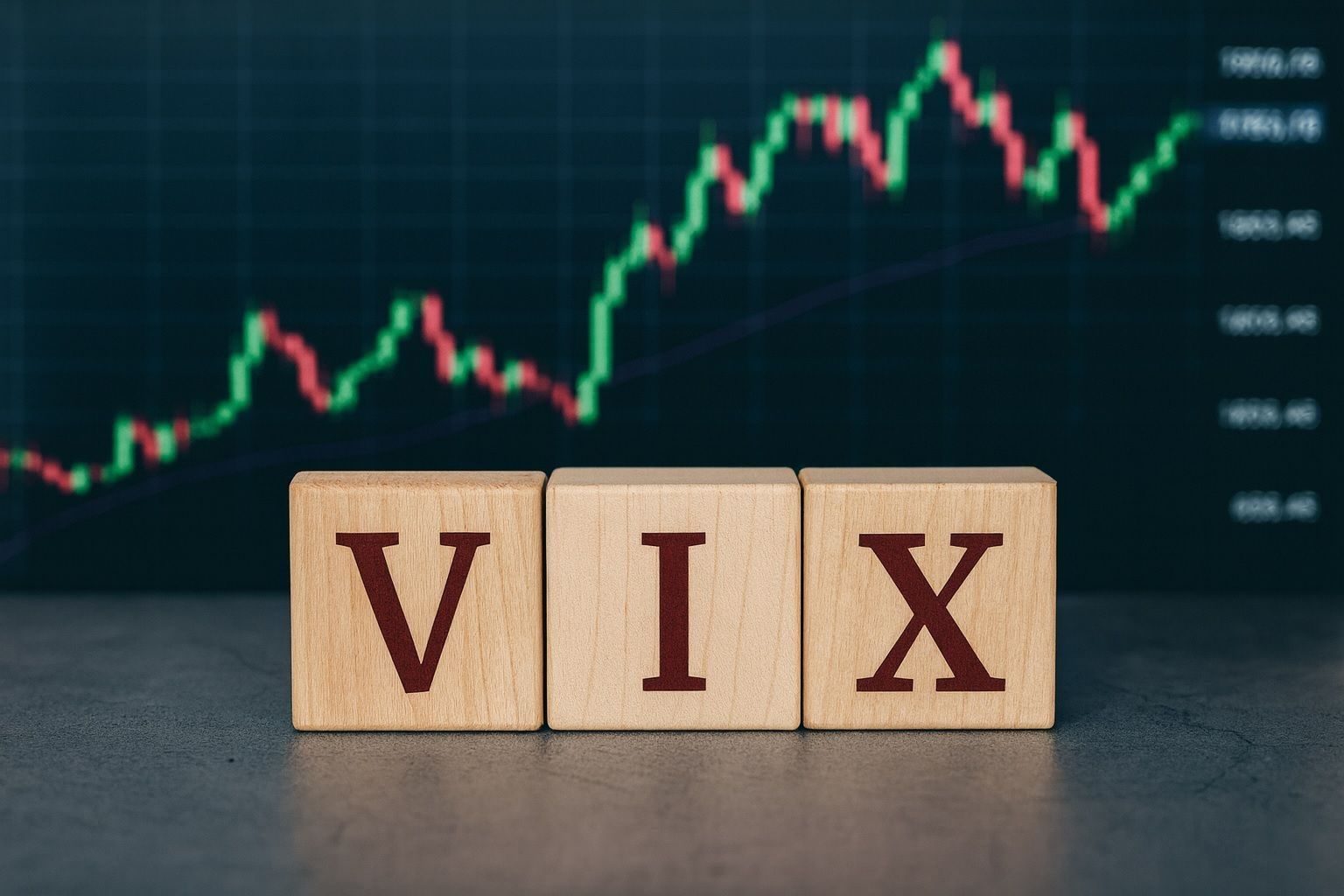Published: November 26, 2025
The Cboe Volatility Index (VIX) — Wall Street’s best‑known “fear gauge” — slid sharply on Wednesday, signaling a fresh bout of calm as U.S. stocks extended their late‑November rebound and traders doubled down on expectations of a Federal Reserve rate cut in December.
According to Cboe’s own trade data, the VIX spot price finished November 26 around 17.0, down just over 8% from Tuesday’s close of 18.56. The index traded in a 16.93–18.70 range during the session, well below last week’s spike into the high‑20s. [1]
That move caps a dramatic four‑session slide: from last Thursday’s close above 26 to roughly 17 today, the VIX has dropped by about 35%, one of the steepest short‑term retreats in volatility this year. [2]
Meanwhile, major U.S. equity benchmarks pushed higher. The Dow Jones Industrial Average gained around 400 pointson Wednesday after a 664‑point surge on Tuesday, while the S&P 500 and Nasdaq Composite also advanced, extending a three‑day winning streak that coincides with the VIX’s latest leg lower. [3]
VIX index today: key numbers at a glance
Based on Cboe and major market data providers, here’s the snapshot for November 26, 2025: [4]
- Spot VIX (end of day): ~17.0
- Change vs Tuesday: roughly -1.5 points (about -8%)
- Previous close (Nov 25): 18.56
- Intraday range: 16.93 (low) to 18.70 (high)
- Recent peak: around 28.3 in mid‑November during a sharp sell‑off in AI‑linked stocks
- 52‑week range: roughly 12.7–60.1
- Long‑term norm: historical averages cluster around 19–20, with a median near 17.6 and a “typical” band from roughly 11–26
In other words, today’s reading sits slightly below the VIX’s long‑run average and solidly inside its normal range, a level more consistent with “cautiously calm” markets than outright fear. [5]
Falling volatility mirrors a three‑day stock market comeback
The slide in volatility is tightly linked to a powerful rebound in U.S. stocks over the last several sessions.
On Tuesday, the Dow climbed 1.4% (about 664 points) to 47,112.45, the S&P 500 added nearly 0.9% to 6,765.88, and the Nasdaq Composite rose roughly 0.7%. Zacks and Nasdaq’s market wrap noted that the VIX dropped 9.6% that day to 18.56, already unwinding much of last week’s spike. [6]
That strength carried into Wednesday. Pre‑market commentary from MarketMinute highlighted rising futures across the Dow, S&P 500, and Nasdaq — pointing to a potential fourth straight up session — as investors embraced a “risk‑on” tone heading into the Thanksgiving break. [7]
Rate‑cut optimism is a key driver. Futures markets now assign 80–85% odds to a 25‑basis‑point Fed rate cut in December, according to CME FedWatch probabilities cited by multiple outlets, up from roughly 40% just a few days ago after dovish comments from New York Fed President John Williams and other policymakers. [8]
At the same time:
- The 10‑year U.S. Treasury yield has drifted near 4%, easing from recent highs. [9]
- Economic data such as initial jobless claims and durable goods orders have been solid but not alarming, reinforcing the “soft landing” narrative that supports equities without stoking fears of runaway inflation. [10]
All of this tends to depress the price investors are willing to pay for downside protection via S&P 500 options — and because the VIX is derived from those option prices, it naturally drifts lower alongside improving sentiment. [11]
From AI‑driven jitters to today’s “wild swings” in the VIX
Today’s calm comes hard on the heels of a notably turbulent stretch for volatility.
In the week of November 17, a rapid sell‑off in high‑flying AI and mega‑cap tech stocks triggered what MarketMinute described as an “indiscriminate” shakeout. During that period, the VIX briefly spiked to about 28.3, reflecting intense short‑term anxiety. [12]
Reuters similarly reported that as of late last week, the VIX had pushed above the key 20 level and its futures curve had flattened, signaling expectations of lingering volatility into the holiday season amid doubts about Fed rate cuts and concerns that AI leaders might be overvalued. [13]
Other coverage underscores just how choppy the backdrop has been:
- Advisor Perspectives noted that the VIX had risen roughly 30% over the past month and yet ETF investors kept pouring money into broad S&P 500 trackers like Vanguard’s VOO, suggesting that many long‑term investors were willing to look through the noise. [14]
- A MoneyShow column on November 26 pointed out that Nvidia’s earnings sparked one of the sharpest recent drops in the S&P 500 and that implied volatility “heated up,” creating oversold conditions in some indicators. [15]
Against that backdrop, the four‑day plunge in VIX from the mid‑20s to about 17 stands out. Bloomberg’s markets coverage described this as a more‑than‑35% slide in the fear gauge over a short window — a pace of normalization comparable to some of the fastest volatility comedowns in recent history. [16]
Earlier this year, a separate analysis highlighted by Investopedia showed the VIX dropping from above 40 back below 20in just three weeks after the Trump administration paused a round of tariffs — the fastest normalization since the index began in 1990. [17]
The pattern: volatility spikes can evaporate quickly when policy fears subside or bad news proves less catastrophic than feared.
What does a VIX reading near 17 actually mean?
For newer readers, it’s worth decoding what today’s number implies.
The VIX is not a forecast of whether stocks will go up or down. Instead, it translates S&P 500 index option prices into a 30‑day, annualized volatility estimate — essentially how large a move traders expect over the next month, in either direction. [18]
Roughly speaking:
- A VIX of 17 implies the market expects about 17% annualized volatility in the S&P 500 over the next 30 days.
- That corresponds to a typical daily move of around 1–1.1% (up or down), assuming volatility is evenly distributed.
- Historically, the VIX has averaged about 19–20 since the early 1990s, with a standard deviation near 8 percentage points. [19]
Educational pieces published today, such as MooLoo’s “Decoding the VIX,” and long‑running data from Cboe and independent researchers broadly agree on some rule‑of‑thumb ranges: [20]
- 12–20: typical of calm or “normal” markets
- 20–30: elevated uncertainty; swings tend to feel choppier
- Above 30: genuine stress or fear
- Single digits: rare periods of complacency
By that framework, today’s VIX near 17 signals “calm but not complacent” conditions: volatility is below the long‑term average but nowhere near the ultra‑low levels seen in some pre‑crisis periods.
Strategists warn the calm may be deceptive
Not everyone is convinced that today’s lower VIX marks the all‑clear.
A detailed note from StoneX, highlighted in a MarketMinute article published this morning, argues that the current period of stability may be “the eye of the storm” in a broader shift toward a more volatile economic backdrop. The firm points to: [21]
- Persistent geopolitical tensions
- Diverging central bank policies
- Structural themes like the energy transition and potential commodities supercycle
StoneX’s analysts emphasize tools such as the VIX and Average True Range (ATR) as essential in navigating this environment and suggest that higher volatility could become a tailwind for firms specializing in derivatives, hedging, and risk management. [22]
Schwab’s morning commentary, while noting that “volatility has eased appreciably this week,” also highlights that VIX futures remain in contango — contracts for early 2026 trade above 21–22, implying the market expects higher volatility further out than today’s spot reading suggests. [23]
And Reuters’ weekend look‑ahead warned that even with Friday’s brief retreat, the VIX’s earlier move above 20 and an unusually flat futures curve were signaling choppier trading into year‑end as doubts about AI valuations and the timing of Fed cuts linger. [24]
Put together, the message is nuanced:
The VIX is low again, but the underlying backdrop — stretched tech valuations, heavy AI capital spending, tariff uncertainties, and a data‑dependent Fed — still argues for episodic volatility rather than a permanent return to the sleepy, pre‑2020 regime. [25]
How traders and long‑term investors might interpret today’s VIX
While every portfolio is different (and nothing here is personal financial advice), today’s volatility backdrop carries some practical implications:
1. For options traders and hedgers
- Index options are cheaper than they were a week ago. With implied volatility lower, hedging via S&P 500 puts or trading volatility strategies typically costs less than during last week’s spike. [26]
- However, a low VIX also means less compensation for selling volatility (e.g., covered calls, short VIX products), and history shows that selling volatility aggressively after a sharp drop can be dangerous if another shock hits.
2. For asset allocators and ETF investors
- The Advisor Perspectives piece on VOO’s record inflows shows that many investors continued buying broad U.S. equity exposure even as the VIX climbed 30% over the past month, reinforcing the idea that volatility spikes don’t have to derail long‑term plans. [27]
- With the VIX back near its historical median, the market is pricing in moderate risk, not extreme fear or euphoria — a backdrop where diversification and disciplined rebalancing tend to matter more than tactical volatility bets. [28]
3. For newer investors watching the “fear gauge”
Educational pieces released today emphasize that the VIX works best as context, not a trading signal: high readings highlight stress, low readings highlight calm, but neither guarantees what stocks will do next. [29]
If anything, knowing that the VIX is “only” around 17 can help temper emotional reactions to headlines: the options market is currently predicting reasonably normal levels of turbulence in the month ahead, even if recent memories of 25–30+ readings make every wobble feel more dramatic than it is. [30]
What could move the VIX next?
Several upcoming catalysts could jolt volatility in either direction:
- December 9–10 FOMC meeting: Markets are heavily pricing in a rate cut. Any surprise — on the decision itself or the forward guidance — could spark a quick repricing in both yields and the VIX. [31]
- Key U.S. data releases: Jobs, inflation, and growth figures in early December will either confirm the “soft landing” narrative or revive recession worries. [32]
- AI and mega‑cap earnings guidance: With AI leaders powering much of this year’s rally and having just endured a bout of valuation anxiety, any new guidance or capex revisions from names like Nvidia, Alphabet, or Microsoft could move both the S&P 500 and the VIX. [33]
- Geopolitical headlines and tariff policy: Earlier in 2025, tariff announcements and reversals were enough to drive the VIX above 40 and then back below 20 in a few weeks. The same playbook could re‑emerge if trade tensions flare again. [34]
With U.S. markets closed on Thursday for Thanksgiving and Friday’s session shortened, thin holiday liquidity could also magnify any surprise headlines, even if many traders would prefer a quiet finish to November. [35]
Bottom line
On November 26, 2025, the VIX index has:
- Dropped back toward 17,
- Erased much of last week’s AI‑driven volatility spike, and
- Aligned more closely with its long‑term historical norms,
all while U.S. stocks enjoy a multi‑day rally powered by rising optimism about a year‑end Fed rate cut. [36]
But beneath the calmer surface, strategists and data alike suggest that volatility hasn’t disappeared — it has merely retreated, with futures markets, geopolitical risks, and the still‑unsettled AI boom all pointing to a market that could quickly shift back into a higher‑vol regime if expectations are disappointed. [37]
For investors, that makes today’s VIX reading less a reason to relax completely and more a reminder that staying diversified, managing risk thoughtfully, and avoiding overreactions to single‑day moves remains as important as ever.
References
1. www.cboe.com, 2. www.investing.com, 3. www.nasdaq.com, 4. www.cboe.com, 5. www.macroption.com, 6. www.nasdaq.com, 7. markets.financialcontent.com, 8. www.nasdaq.com, 9. www.schwab.com, 10. www.schwab.com, 11. www.cboe.com, 12. markets.financialcontent.com, 13. www.reuters.com, 14. www.advisorperspectives.com, 15. www.moneyshow.com, 16. www.bloomberg.com, 17. www.investopedia.com, 18. www.cboe.com, 19. www.currentmarketvaluation.com, 20. mooloo.net, 21. markets.financialcontent.com, 22. markets.financialcontent.com, 23. www.schwab.com, 24. www.reuters.com, 25. markets.financialcontent.com, 26. www.investing.com, 27. www.advisorperspectives.com, 28. www.gurufocus.com, 29. mooloo.net, 30. www.investing.com, 31. www.reuters.com, 32. www.reuters.com, 33. markets.financialcontent.com, 34. www.investopedia.com, 35. www.schwab.com, 36. www.cboe.com, 37. markets.financialcontent.com







